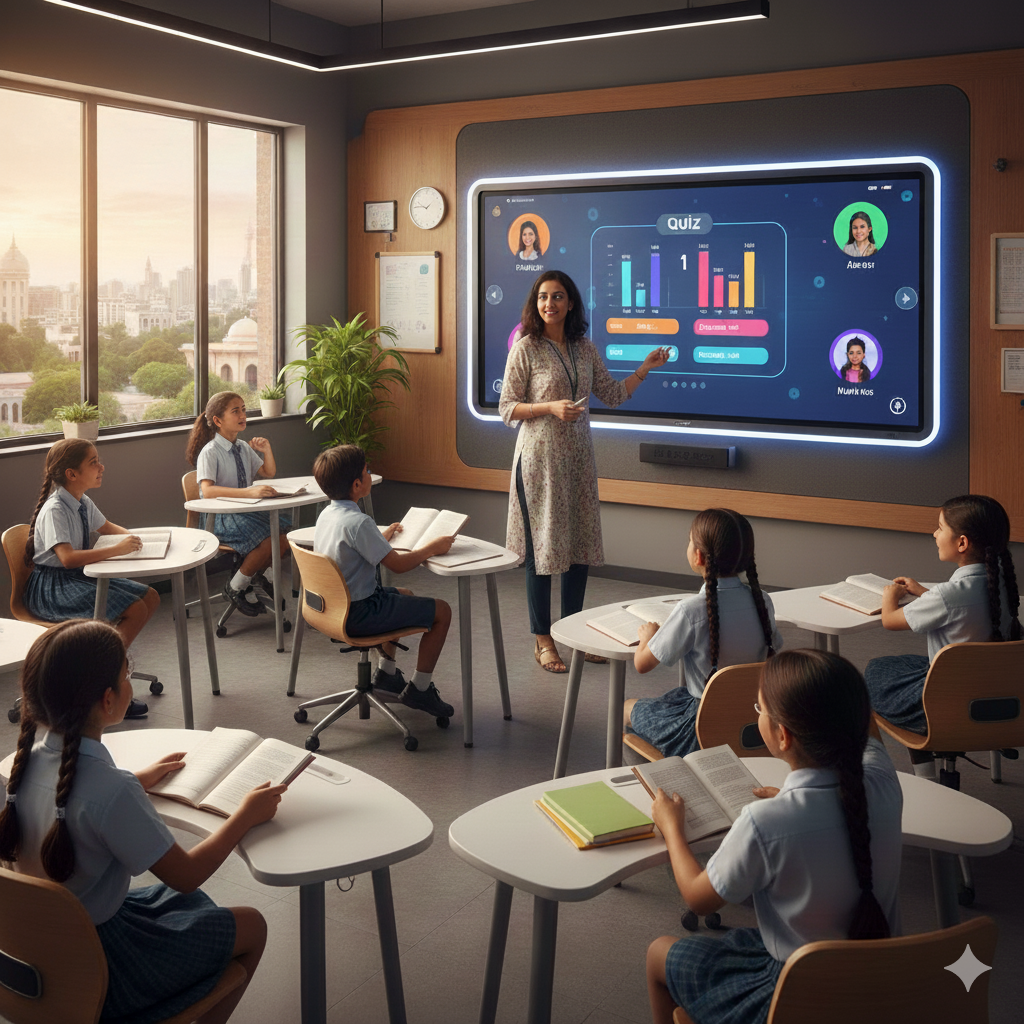Smart Classrooms in 2025: Top Benefits Every School Must Know

The education landscape is changing fast and schools that don’t keep up could risk more than just academic performance. In 2025, a smart classroom isn't just an extra feature anymore. It’s becoming a basic requirement. As students grow up in a digital world, teaching tools must evolve too. If your school is considering the shift, here’s what you really need to know. These are the top benefits of smart classrooms that matter in the Indian context today.
6 Key Advantages of a Smart Classroom
1. Boosts Student Engagement & Retention
Conventional teaching struggles to grab students’ attention now, as they’re used to more interactive and visual input. A digital smart classroom, on the other hand, uses interactive displays, videos, and real-time collaboration tools that make learning visual and immersive.
Technologies like Roombr’s IR-pen-based projection system turn any wall into an interactive space, making lessons more engaging. This shift can improve not just attention spans, but also long-term concept retention. Students are more likely to remember what they actively participate in, rather than passively observe.
2. Personalizes Learning with AI
A major strength of smart classrooms lies in how easily they adjust to different learning needs. Each student processes information differently and moves at their own pace. By integrating AI-driven tools, digital classrooms can track learning patterns, identify gaps, and suggest tailored content for each student. This approach is especially useful in mixed-ability classrooms, which are common across India. While no tool replaces a teacher’s intuition, AI can provide meaningful insights that help educators better support each learner’s growth.
3. Enables Seamless Hybrid & Remote Learning

Source: Freepik
In the post-pandemic world, flexibility in learning delivery isn’t just useful—it’s expected. A smart classroom supports both in-person and remote learning with ease. With platforms like Roombr, teachers can broadcast live sessions, record lessons for later access, and share materials instantly with students at home. This helps bridge gaps for students who may be absent due to health, travel, or family situations. Hybrid learning is also key for higher education and coaching centres looking to expand their reach without investing in physical space.
4. Improves Teacher Productivity
Teachers today face increasing pressure from managing large classes to handling administrative tasks. A digital classroom setup can ease that burden. Smart tools can automate attendance, generate instant quizzes, and simplify content delivery. For instance, Roombr’s integrated system lets educators switch between slides, videos, and web resources using just a pen or gesture, reducing setup time. It gives educators the space to concentrate fully on guiding and supporting students. With less time spent on manual work, lesson quality can improve without increasing workload.
5. Scales Smartly with Cost-Effective Solutions
It’s often assumed that upgrading to a smart classroom means a complete infrastructure overhaul. But that’s not necessarily true. Tools like Roombr are designed to be plug-and-play—working with existing projectors and whiteboards. This makes digital upgrades possible even for schools operating under tight budgets. Compared to bulky smart panels or imported hardware, Roombr offers a scalable, budget-friendly alternative tailored to Indian schools. Over time, schools can expand use case by use case, making the transformation gradual and manageable.
6. Supports Collaboration & Real-Time Feedback
Effective learning often happens through dialogue between students, and between students and teachers. A digital smart classroom enables that with collaborative features such as live polls, shared annotations, instant Q&A, and interactive whiteboarding. These tools promote two-way communication and create space for immediate feedback, which is essential for active learning. Dual-camera systems, for example, allow teachers to present while engaging with students—both online and offline—ensuring no one feels left out of the classroom conversation.
Why Smart Classrooms Are the Future
The future of education isn't just digital, it's deeply human, powered by technology. A smart classroom in 2025 does more than add gadgets to the room. It reshapes how teachers teach and students learn. India’s education system is at a pivotal moment, where policy shifts like NEP 2020 and growing tech access demand smarter, more agile learning spaces. Here's what makes digital smart classrooms not just relevant, but mission-critical:
- Learner-Centric Design: Today’s smart classrooms flip the traditional teacher-led model. They’re built around student interaction, curiosity, and collaboration—allowing every learner to play an active role in their education journey.
- Data-Backed Decision Making: Digital classrooms offer meaningful analytics—not just attendance and marks, but insights into participation trends, engagement levels, and concept mastery. These insights allow teachers to adjust their approach on the go, based on how students are responding.
- Adaptive Infrastructure: Unlike fixed installations, modern smart classroom tools like Roombr are flexible and scalable. Schools can grow their digital footprint gradually without disrupting ongoing operations or needing a full hardware overhaul.
- Teacher-Led Innovation: Far from replacing teachers, smart classrooms empower them to become facilitators, designers, and digital leaders. Educators can try new formats, flipped classrooms, peer-led activities, or integrated assessment, without tech hassles.
- Strategic Investment in Learning Outcomes: Moving to a digital classroom is a forward-looking investment. Institutions that integrate well-designed digital environments often see better academic performance, student satisfaction, and parent engagement.
What’s next? Explore how Roombr can help you build a future-ready smart classroom.
Praveen Krishnaiah
Share
Step Into the future of
Education with Roombr












.png)





